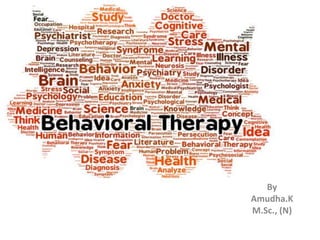
Behavioral therapy
- 3. INTRODUCTION • A behavior is considered to be maladaptive when it is age inappropriate, when it interferes with adaptive functioning, or when others misunderstand it in terms of cultural inappropriateness.
- 4. • The basic assumption is that problematic behaviors occur when there has been inadequate learning and therefore can be corrected through the provision of appropriate learning experiences.
- 5. PRINCIPLES • Classical conditioning by Pavlov (1927) • Operant conditioning by Skinner (1938)
- 7. Pavlov’s model of classic conditioning Sequence of Conditioning Operations: 1. UCS ----------------------------------------------------------------------------- UCR Unconditioned stimulus Unconditioned response (eating food) (salivation) 2. UCS ----------------------------------------------------------------------------------- CR Unconditioned stimulus Conditioned response (sight of food) (salivation) 3. CS ------------------------------------------------------------------------------------------ NR Conditioned stimulus No response or (bell) response unrelated to salivation 4. UCS + CS -------------------------------------------------------------------------------------- CR Unconditioned + Conditioned stimulus Conditioned response (food) (bell) (salivation) 5. CS ------------------------------------------------------------------------------------------------- CR Conditioned stimulus Conditioned response (bell) (salivation)
- 8. Classical Conditioning and Stimulus Generalization Subject: 6 month old baby Sequence of Conditioning Operations: 1. CS -------------------------------------------------------------------------------- NR Conditioned stimulus No response (Nurse A in white uniform walks into room) 2. UCS ----------------------------------------------------------------------------- UCR Unconditioned stimulus Unconditioned response (Nurse A in white uniform gives shot) (cries; clings to mother) 3. CS -------------------------------------------------------------------------------- UCR Conditioned stimulus Conditioned response (Nurse A in white uniform walks into room) (cries; clings to mother) 4. CS ----------------------------------------------------------------------------------- CR Conditioned stimulus Conditioned response (Nurse B in white uniform walks into room) (cries; clings to mother) or (family friend comes to visit wearing a white dress)
- 9. OPERANT CONDITIONING • Stimuli may precede or follow a behavior. • A stimulus that follows a behavior (or response) is called a reinforcing stimulus or reinforcer. The function is called reinforcement. • When the reinforcing stimulus increases the probability that the behavior will recur, it is called a positive reinforcer, and the function is called positive reinforcement.
- 10. Contd., • Negative reinforcement is increasing the probability that a behavior will recur by removal of an undesirable reinforcing stimulus. • A stimulus that follows a behavioral response and decreases the probability that the behavior will recur is called an aversive stimulus or punisher. Examples of these reinforcing stimuli are presented as
- 11. Examples of Reinforcing Stimuli Type Stimulus Behavioural response Reinforcing stimulus Positive Messy room Child cleans her messy room. Child gets allowance for cleaning room. Negative Messy room Child cleans her messy room. Child does not receive scolding from the mother. Aversive Messy room Child does not clean her messy room. Child receives scolding from the mother.
- 12. MAJOR ASSUMPTIONS • All behavior is learned (adaptive and maladaptive). • Human beings are passive organisms that can be conditioned or shaped to do anything if correct responses are rewarded or reinforced. • Maladaptive behavior can be unlearned and replaced by adaptive behavior • Behavioral assessment is focused more on the current behavior rather than on historical antecedents. • Treatment strategies are individually tailored.
- 13. INDICATIONS
- 14. INDICATIONS
- 15. INDICATIONS
- 16. INDICATIONS
- 17. INDICATIONS
- 18. INDICATIONS
- 20. SHAPING • Shaping has been shown to be an effective way of modifying behavior for tasks that a child has not mastered on command or are not in the child’s repertoire.
- 21. MODELING • Modeling refers to the learning of new behaviors by imitating the behavior in others.
- 22. Discriminative stimulus (Homework assignment: to do or not to do) R2 (Completion of homework assignment) R1 (Talk to friends on telephone) PREMACK PRINCIPLE
- 23. TOKEN ECONOMY • With this therapy, tokens are awarded when desired behaviors are performed and may be exchanged for designated privileges.
- 25. SYSTEMATIC DESENSITIZATION • Discuss riding an elevator with the therapist. • Look at a picture of an elevator. • Walk into the lobby of a building and see the elevators. • Push the button for the elevator. • Walk into an elevator with a trusted person; disembark before the doors close. • Walk into an elevator with a trusted person; allow doors to close; then open the doors and walk out. • Ride one floor with a trusted person and then walk back down the stairs. • Ride one floor with a trusted person and ride the elevator back down. • Ride the elevator alone.
- 26. ADVANTAGES • Behavioral therapists use empirically tested techniques, assuring that clients are receiving both effective and brief treatment • Evidence-based therapies (EBT) are a hallmark of both behavior therapy and cognitive behavior therapy • Most studies show that behavior therapy methods are more effective than no treatment • Emphasis on ethical accountability (does not dictate whose behavior or what behavior should be changed) • Address ethical issues by stating that therapy is basically an education process; an essential feature of behavior therapy involves collaboration between therapist & client
- 27. DISADVANTAGES • Behavior therapy may change behaviors, but it does not change feelings • Behavior therapy ignores the important relational factors in therapy • Behavior therapy does not provide insight • Behavior therapy treats symptoms rather than causes • Behavior therapy involves control & manipulation by therapist
- 28. CASE SCENARIO
- 29. ROLE OF THE NURSE Nursing diagnoses Outcome criteria Noncompliance with therapy Sammy participates in and cooperates during therapeutic activities. Defensive coping Sammy accepts responsibility for own behaviours and interacts with others without becoming defensive Impaired social interaction Sammy interacts with staff and peers using age appropriate, acceptable behaviours.